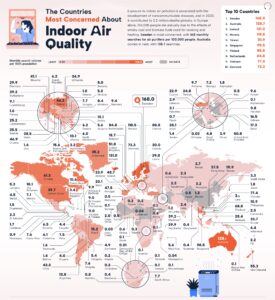EU warning over air quality outlook
EEA says air quality ‘slowly improving’ but policy implementation and behavioural changes needed to protect future health
Air quality in Europe is ‘slowly improving’ but full implementation of existing EU policies as well as fundamental technical and behavioural changes are needed to adequately protect human health, the European Environment Agency’s latest five-yearly report warns today (March 3).
The EEA estimates that as a result of current policy work, air quality will further improve up to 2030, but that harmful levels of air pollution will still persist beyond this point — particularly with regards to fine particulate matter (PM2.5) and ground-level ozone (O3), which continue to cause ‘serious impacts on health’.

EEA warns that thousands will continue to die prematurely from air pollution over th next two decades (photo: EEA and Pleven)
According to the EEA, an agency of the European Union, there were around 430,000 premature deaths in EU Member States in 2011 attributed to PM2.5, while the estimated impact of exposure to O3 concentrations exceeded 16,000Â premature deaths per year.
And, the report argues that thousands will continue to die prematurely up to 2030 and beyond unless current and planned EU policies are fully implemented, more money is invested in alternatively-fuelled vehicles and more Europeans are encouraged towards walking and cycling.
Nitrogen dioxide (NO2) — particularly from road traffic — and polycyclic aromatic hydrocarbons (PAHs) such as benzo(a)pyrene (BaP), for which a major source is domestic and commercial coal and wood burning, are also listed as problem pollutants for Europe over the next 10-20 years.
Emissions of benzo(a)pyrene increased by 21% between 2003 and 2012, which the EEA says was driven by the increase (24%) in emissions from domestic combustion in Europe.
Published today (March 3), the EEA’s ‘State and outlook 2015’ report assesses EU environmental work in recent years and aims to inform European environmental policy and its implementation between 2015 and 2020 in particular.
Transport
On top of both planned and existing EU regulations, the report emphasises the importance of developing alternative fuelled vehicles ‘to reduce the burden placed on the environment by the transport system’.
However, the EEA concedes that this will require ‘very large investments in infrastructure (in both the transport and energy sectors) and the displacement of entrenched fossil fuel-based systems’.
Furthermore, alternative fuelled vehicle infrastructure ‘will not solve other problems such as congestion, road safety, noise levels and land use’.
As such, the EEA also suggests that ‘fundamental changes in the way Europe transports passengers and goods will be needed’, calling for a greater focus on encouraging citizens away from private vehicles and towards public transport, walking and cycling.
Industry
Air pollution emissions from industrial sources are expected to continue falling over the next 20 years, but the harm to human health from these emissions ‘remains considerable’, the study suggests.
In 2012, industry accounted for 85% of emissions of sulphur dioxide (SO2), 40% of emissions of nitrogen oxides (NOx), 20% of emissions of fine particulate matter (PM2.5) and non-methane volatile organic compounds (VOCs), and 50% of greenhouse gas emissions in the EEA’s 33 member countries.
Part of the plan towards cutting industrial sulphur oxides (SOx), NOx and particulate matter emissions, the EEA argues, should focus on reducing Europe’s reliance on fossil fuels by reducing energy consumption and switching to alternative energy sources.
But the report also suggests that existing and planned policies will help reduce the impacts of industry on air quality, such as further implementation of the Industrial Emissions Directive.
Specifically, it also highlights further the future Directive to limits emissions from medium-sized combustion plants, which is currently being discussed as part of the Commission’s Clean Air Policy Package.
This latter proposal is expected to reduce the annual emissions from medium plants by an estimated 45% for sulphur dioxide (SO2), 19% for nitrogen oxides (NOx), and 85% for particulate matter.
Indoor and noise
The report also makes the point that although European citizens spend more than 85% of their time indoors, there is ‘currently no dedicated policy framework that bridges safety, health, energy efficiency and sustainability’.
And, on noise, the EEA says that while this is increasingly being recognised as a public health issue, tackling noise pollution is ‘challenging’ because it is a ‘direct consequence of societies demand and need for mobility and productivity’.
Road traffic is considered the greatest contributor to noise exposure in Europe, and most recently the EEA estimates that environmental noise contributes to around 10,000 premature deaths due to coronary heart disease and stroke each year.
It adds that almost 90% of noise-related health impacts are associated with road traffic.
Commenting on the EEA’s fifth five-yearly outlook report, Hans Bruyninckx, EEA executive director, said: “Our analysis shows that European policies have successfully tackled many environmental challenges over the years. But it also shows that we continue to harm the natural systems that sustain our prosperity.”
He added: “We need our actions and investments to be even more ambitious and more coherent. Many of the decisions we make today will determine how we are going to live in 2050.”













